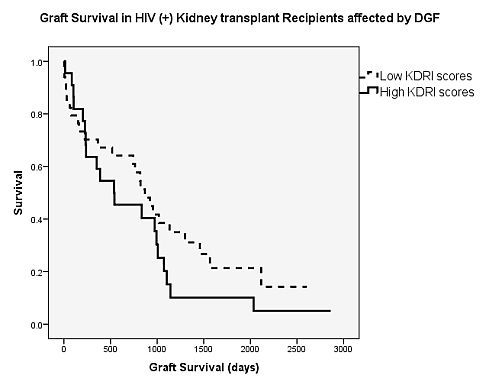Impact of Delayed Graft Function (DGF) and KDRI on Kidney Graft Survival in HIV (+) Transplant Recipients (HIV KTx)
Transplantation, Drexel University College of Medicine, Philadelphia, PA
Meeting: 2013 American Transplant Congress
Abstract number: C1271
Background: Kidney transplant graft survival remains suboptimal in HIV (+) patients. We, and others, have reported an association of both DGF with markedly inferior graft outcomes. More recently, KDRI has been validated as a tool to predict graft outcomes but has not been well characterized for HIV (+) transplant patients. We sought to investigate the overlapping effects between DGF and KDRI on graft survival within a large single center experience of HIV KTx.
Methods: We retrospectively examined 91 sequential deceased donor HIV KTx. Unadjusted KDRI was calculated for each recipient. We compared two groups: the highest KDRI (high KDRI) vs. the lowest score (low KDRI). We then examined the total cohort for the incidence DGF, and compared those with the highest KDRI + DGF vs. the lowest KDRI + DGF. KDRI values were mapped to the 2012 KDPI table. KDRI values correlating to the newly established 85% KDPI limit were identified as the cutoff for the two groups.
Results: Demographics of the two groups similar (Table 1). The KDRI was used to compare graft survival between the 2 groups and as expected, was worse in the high KDRI group (p=0.01, data not shown). When KDRI was used to compare graft survival in HIV (+) transplant recipients among the group that had DGF, we found no difference in graft outcomes between high- and low-KDRI groups. Graft function (eGFR) was markedly worse in the high KDRI group.
Conclusion: High KDRI performed less well than presence/absence of DGF as a predictor of poor graft survival for HIV (+) kidney transplant patients. This may suggest that factors associated with DGF, beyond those captured in KDRI, may play a prominent role in graft survival in this population.
| Demographics | Low Risk KDRI (n=60) | High Risk KDRI (n=31) | p-value |
| Male (%) | 83 | 90 | 0.53 |
| African American (%) | 87 | 94 | 0.25 |
| Recipient Age (mean ± s.d.) | 47 ± 9.3 | 50 ± 8.1 | 0.13 |
| CIT (mean ± s.d.) | 16 ± 6.1 | 16 ± 5.4 | 0.96 |
| DGF (%) | 57 | 71 | 0.26 |
| ACR (%) | 68 | 74 | 0.63 |
| Mixed Rejection (%) | 18 | 10 | 0.37 |
| 1 yr. eGFR (mean ± s.d.) | 40.0 ± 30.0 | 25.4 ± 24.0 | 0.04 |
| 3 yr eGFR (mean ± s.d.) | 29.3 ± 33.5 | 9.3 ± 15.6 | 0.01 |
| Best eGFR (mean ± s.d.) | 58.8 ± 28.2 | 44.0 ± 19.7 | 0.02 |

To cite this abstract in AMA style:
Malat G, Ranganna K, Guy S, Xiao G, Reich D, Doyle A. Impact of Delayed Graft Function (DGF) and KDRI on Kidney Graft Survival in HIV (+) Transplant Recipients (HIV KTx) [abstract]. Am J Transplant. 2013; 13 (suppl 5). https://atcmeetingabstracts.com/abstract/impact-of-delayed-graft-function-dgf-and-kdri-on-kidney-graft-survival-in-hiv-transplant-recipients-hiv-ktx/. Accessed December 15, 2025.« Back to 2013 American Transplant Congress
